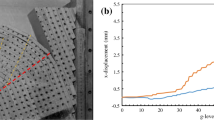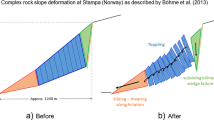Summary
Toppling Rock Slope Failures — Examples of Analysis and Stabilization
Three case histories of toppling failures of rock slopes, and the methods used to ensure that failure did not disrupt operations below the slope, are described. The application of Goodman and Bray's limit equilibrium analysis of multi-block failures to these three slopes is demonstrated.
The first failure occurred in a 20 m high granite slope that was stabilized by removing the top 6 m and installing a number of tensioned rock anchors in the toe. The second failure occurred in a sequence of folded sandstone, shale and coal. This slide was too large to stabilize, so the movement rate was monitored while mining continued in the pit below until shortly before failure took place. In the third failure, the top 8 m of a single 12 m high toppling block was removed by blasting to prevent further rotational movement.
Zusammenfassung
Kippvorgänge beim Bruch von Felsböschungen — Beispiele für die Berechnung und Stabilisierung
Es werden drei Fallstudien von Brüchen von Felsböschungen durch Kippen und die dabei angewendeten Sicherungsmethoden beschrieben. Die Anwendung der Grenzgleichgewichtsbetrachtung von Massenbewegungen, die durch Kippvorgänge ausgelöst wurden, nach Goodman and Bray, auf drei Felshänge wird gezeigt.
Der erste Bruch ereignete sich in einer 20 m hohen Böschung in Granit. Die Stabilisierung bestand in der Entfernung der obersten 6 m und der Einbringung von einigen Vorspannankern. Der zweite Bruch ereignete sich in einer Serie von gefalteten Sandsteinen, Schiefern und Kohlen. Da die Größe dieser Rutschung eine Stabilisierung unmöglich machte, wurden die Bewegungen genau registriert und der Abbau bis kurz vor dem eigentlichen Bruch fortgesetzt. Das dritte Beispiel ist ein einzelner 12 m hoher, kippender Block, dessen oberste 8 m weggesprengt wurde, um ein weiteres Kippen zu verhindern.
Résumé
Défauts par chute de rampes rocheuses — Exemples des analyses et de stabilisation
Ce résumé décrit trois événements de rupture de pentes rocheuses et les méthodes de stabilisation utilisées. Dans ces trois cas l'auteur montre l'utilisation de l'analyse de la limite d'équilibre des masses rocheuses pour un mouvement de basculement selon Goodman et Bray.
Le premier cas a eu lieu sur une rampe granitique de 20 m hauteur, laquelle a été stabilisée en 6 m de roche au sommet et en possant quelque d'ancrage au pied de la pente. La deuxième défaut s'a produit avec une séquence de roches de formation gréseuse, d'argile schisteuse et du charbon. Cette glissement a été trop grande pour être stabilisée, donc la raison de mouvement a été controlée au même temps qu'on travaillait dans le puit au dessous quelque temps avant que le défaut se produisse. Dans le troisième défaut les 8 m de sommet d'un seul bloc rocheux ont été dépilés par des méthodes explosifs pour prévenir ultérieur mouvements rotatives.
Similar content being viewed by others
References
Barton, N. (1971): A Model Study of the Behaviour of Steep, Excavated Rock Slopes, PhD. Thesis, Imperial College, Royal School of Mines, London.
Brawner, C. O., Wyllie, D. C. (1975): Rock Slope Stability on Railway Projects, American Railway Engineering Association, Regional Meeting, Vancouver, B. C.
Burman, B. C. (1971): Some Aspects of the Mechanics of Slopes and Discontinuous Media, PhD. Thesis, James Cook University of N. Queensland, Townsville, Australia.
Byrne, R. J. (1974): Physical and Numerical Models in Rock and Soil Slope Stability, PhD. Thesis, James Cook University of N. Queensland, Townsville, Australia.
Cundall, Peter (1971): A Computer Model for Simulating Progressive, Large Scale Movements in Blocky Rock Systems, Proceedings International Symposium on Rock Fractures, Nancy, France, Paper II-8.
Goodman, R. E., Bray, J. (1976): Toppling of Rock Slopes, Proceedings of Speciality Conference on Rock Engineering for Foundations and Slopes, Boulder, CO, Vol. 2.
Hittinger, M. (1978): Numerical Analysis of Toppling Failures in Jointed Rock, PhD. Thesis, University of California, Berkeley.
Hoek, E., Bray, J. (1977): Rock Slope Engineering (2nd Edition), I. M. M. London.
John, K. W. (1970): Three Dimensional Stability Analysis of Slopes in Jointed Rock, Planning Open Pit Mines, Proceedings of Symposium in Johannesburg, South Africa.
Soto, C. (1974): A Comparative Study of Slope Modelling Techniques for Fractured Ground, MSc. Thesis, Imperial College, Royal School of Mines, London.
Wyllie, D. C., Munn, F. J. (1979): The Use of Movement Monitoring to Minimize Production Losses Due to Pit Slope Failures, Proceedings of the 1st International Symposium on Stability in Coal Mining, Vancouver, B. C.
Author information
Authors and Affiliations
Additional information
With 6 Figures
Rights and permissions
About this article
Cite this article
Wyllie, D.C. Toppling rock slope failures examples of analysis and stabilization. Rock Mechanics 13, 89–98 (1980). https://doi.org/10.1007/BF01238952
Received:
Issue Date:
DOI: https://doi.org/10.1007/BF01238952




